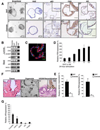Identification of multipotent luminal progenitor cells in human prostate organoid cultures
- PMID: 25201529
- PMCID: PMC4772677
- DOI: 10.1016/j.cell.2014.08.017
Identification of multipotent luminal progenitor cells in human prostate organoid cultures
Abstract
The prostate gland consists of basal and luminal cells arranged as pseudostratified epithelium. In tissue recombination models, only basal cells reconstitute a complete prostate gland, yet murine lineage-tracing experiments show that luminal cells generate basal cells. It has remained challenging to address the molecular details of these transitions and whether they apply to humans, due to the lack of culture conditions that recapitulate prostate gland architecture. Here, we describe a 3D culture system that supports long-term expansion of primary mouse and human prostate organoids, composed of fully differentiated CK5+ basal and CK8+ luminal cells. Organoids are genetically stable, reconstitute prostate glands in recombination assays, and can be experimentally manipulated. Single human luminal and basal cells give rise to organoids, yet luminal-cell-derived organoids more closely resemble prostate glands. These data support a luminal multilineage progenitor cell model for prostate tissue and establish a robust, scalable system for mechanistic studies.
Copyright © 2014 Elsevier Inc. All rights reserved.
Conflict of interest statement
The other authors declare no conflict of interest
Figures






Comment in
-
Innovation: organoids-a better model for prostate cancer.Nat Rev Urol. 2014 Nov;11(11):604. doi: 10.1038/nrurol.2014.269. Epub 2014 Sep 23. Nat Rev Urol. 2014. PMID: 25245237 No abstract available.
-
Cell biology: Prostate cancer in 3D.Nat Methods. 2014 Nov;11(11):1096. doi: 10.1038/nmeth.3167. Nat Methods. 2014. PMID: 25551127 No abstract available.
-
Re: Organoid cultures derived from patients with advanced prostate cancer.J Urol. 2015 Apr;193(4):1442-3. doi: 10.1016/j.juro.2015.01.059. Epub 2015 Jan 20. J Urol. 2015. PMID: 25890569 No abstract available.
References
-
- Barker N, Huch M, Kujala P, van de Wetering M, Snippert H, van Es J, Sato T, Stange D, Begthel H, van den Born M, et al. Lgr5(+ve) stem cells drive self-renewal in the stomach and build long-lived gastric units in vitro. Cell stem cell. 2010;6:25–36. - PubMed
Publication types
MeSH terms
Substances
Grants and funding
LinkOut - more resources
Full Text Sources
Other Literature Sources
Medical
Research Materials

